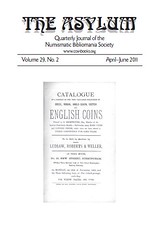
About UsThe Numismatic Bibliomania Society is a non-profit organization promoting numismatic literature. For more information please see our web site at coinbooks.org SubscriptionsThose wishing to become new E-Sylum subscribers (or wishing to Unsubscribe) can go to the following web page link MembershipThere is a membership application available on the web site Membership Application To join, print the application and return it with your check to the address printed on the application. Membership is only $15 to addresses in the U.S., $20 for First Class mail, and $25 elsewhere. For those without web access, write to: David M. Sundman, Secretary/TreasurerNumismatic Bibliomania
Society AsylumFor Asylum mailing address changes and other membership questions, contact David at this email address: dsundman@LittletonCoin.com SubmissionsTo submit items for publication in The E-Sylum, just Reply to this message, or write to the Editor at this address: whomren@coinlibrary.com
BUY THE BOOK BEFORE THE COINYou won't regret it! |
- WAYNE'S WORDS: THE E-SYLUM OCTOBER 30, 2011
- THE ASYLUM, VOLUME 29, NUMBER 2 PUBLISHED
- NEW BOOK: POP OUT REPOUSSE COINS
- NEW BOOK: ELECTRUM AND THE INVENTION OF COINAGE
- NEW BOOK: HISTORY OF OTTOMAN COINS VOL 4
- NEW BOOK: MILITARY TOKENS OF THE BRITISH COMMONWEALTH
- BOOK REVIEW: MONEYMAKERS BY BEN TARNOFF
- RED BOOK LAUNCHED FAMILY BUSINESS 50 YEARS AGO
- MORE ON AMERICAN FAROUK AUCTION ATTENDEES
- QUERY: PEWTER TRIBUTE MEDALS INFORMATION SOUGHT
- MONTROVILLE WILSON DICKESON
- THE NUMISMATIST NOW AVAILABLE FOR ANDROID PHONES
- THE 2012 LONDON OLYMPICS MEDALS
- NOTES FROM E-SYLUM READERS: OCTOBER 30, 2011
- AUSTRALIA TOPS CANADA WITH WORLD'S LARGEST GOLD COIN
- QATARI SHEIK ON COIN-BUYING SPREE
- 1938 "SUPERMAN" CHECK OFFERED FOR SALE
- MORE BANKNOTES AS BUSINESS CARDS
- QUERY: THE 1841 MAUNDY THREEPENCE
- MORE ON COINS AND MEDALS AND METEORITES
- LIBYA'S TREASURE OF BENGHAZI COIN COLLECTION STOLEN
- BITCOINS GO FROM VIRTUAL TO PHYSICAL
- OBITUARY: SIR ARTHUR NORMAN, BANKNOTE PRINTER
- BANKNOTES WORTH MORE WHEN TORN IN TWO
- MARK WAGNER'S MONEY ART
- FEATURED WEB PAGE: LIBYAN BANKNOTES AND COINS
WAYNE'S WORDS: THE E-SYLUM OCTOBER 30, 2011

Among our new subscribers this week is Carl Wolf. Welcome aboard! We have 1,469 email subscribers, plus 168 followers on Facebook, including Say Peng.
This week we open with word on the latest issue of our print publication, The Asylum, followed by announcements of FOUR new numismatic titles and my review of Moneymakers by Ben Tarnoff.
Other topics this week include Pewter Tribute medals, Montroville Wilson Dickeson, 2012 London Olympics medals, Meteorite medals, and a coin-buying Qatari Sheik.
To learn more about Pop-Out Coins, Two-Faced Coins, the World's Largest Gold Coin, Ed Frossard's business card, the "Honey, I Shrunk the Mint Employees" movie and when a banknote is worth MORE when torn in two, read on. Have a great week, everyone!
Wayne Homren
Numismatic Bibliomania Society
THE ASYLUM, VOLUME 29, NUMBER 2 PUBLISHED
- Joel Orosz - The Second United States Mint and Good Child's Library
- Myron Xenos - "You Don't Say": Numismatic Quarterly Quiz
- Paul Withers - The Shorthouse Catalogue
- Dave Hirt - Memories of Katen Auction Sales
- List of Issues of The Asylum by Volume and Number, 1980-2010
Ray Williams noticed a typo and we both got a grin out of it. Or are Kolbe & Fanning just trying to keep us on our toes? Anyway, I'll leave it to NBS members to look it up. He writes:
I always enjoy reading those historical quotes that are on the inside of the front cover. I forget who was quoted, but he seemed to live a very long life (except for those of Old Testament times).
NEW BOOK: POP OUT REPOUSSE COINS
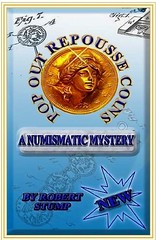 A new booklet has just been published on Pop-Out Coins, also known as Repoussé, Pop-Up and Pushed-Up Coins. The first-edition of the booklet is limited to only 100 copies!
A new booklet has just been published on Pop-Out Coins, also known as Repoussé, Pop-Up and Pushed-Up Coins. The first-edition of the booklet is limited to only 100 copies!
It contains the FIRST and ONLY available information on these beautiful off-the-beaten-path artistic & numismatic creations.
This booklet was written by Robert (Stumpy) Stump, who passed away a few days after the book was sent to print. It was written in the hopes of shedding some light on this mysterious, interesting and little known part of numismatics and introducing it to new collectors and fans.
In the Preface, Bob Writes: "Taking advice from all the old time collectors I have known "Buy the book, and then buy the coin". I went on the internet to find a book and other information on the subject. To my surprise there was almost nothing available... I thought how can this be? Such a beautiful art form and nothing is much known about them?".
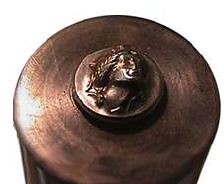 Most numismatist have probably seen Miss Liberty pop-outs, as well as a few Presidents, with Lincoln being the most common, but there are many more pop-outs that show fabulous images, such as animals, Indians, political, religious, Fraternal clubs, Foreign themes, etc. - all detailed and pictured in this booklet.
Most numismatist have probably seen Miss Liberty pop-outs, as well as a few Presidents, with Lincoln being the most common, but there are many more pop-outs that show fabulous images, such as animals, Indians, political, religious, Fraternal clubs, Foreign themes, etc. - all detailed and pictured in this booklet.
Many pop-outs were made into jewelry, such as fobs, rings, pins, brooches, pendants, cuff links, etc.
The 83-page fully-color spiral-bound booklet includes a plethora of information that is known only to very few and never compiled into any publication whatsoever. It includes information regarding the making of these work of art, replicas & forgeries, myths & legends, cleaning & storing, a comprehensive research and findings regarding their patents & designs, and most important - the first ever pictured price guide to Pop-Outs!
The book is being sold by Bob's friend and fellow pop-ups collector, Oded Paz, for $20 (incl. S&H in the USA). For orders, email Oded at pop-up@sbcglobal.net, or send cash, checks or money orders to: Oded Paz, P.O.Box 633, Arco, ID 83213-0633
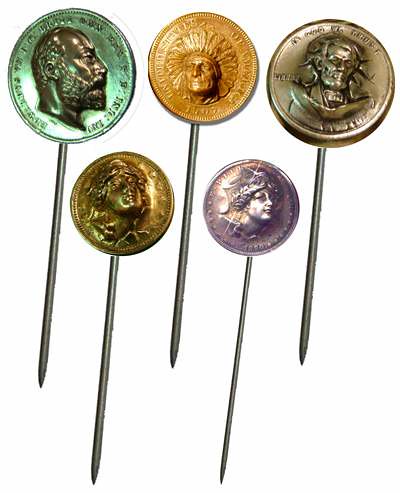
NEW BOOK: ELECTRUM AND THE INVENTION OF COINAGE
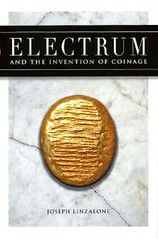 Joseph Linzalone, Electrum and the invention of coinage. Dennis McMillan Publications 2011. 246 p. with colour illustrations. ISBN 978-0-939767-62-5. Hardcover. 23.5x15.7 cm. $85.00.
Joseph Linzalone, Electrum and the invention of coinage. Dennis McMillan Publications 2011. 246 p. with colour illustrations. ISBN 978-0-939767-62-5. Hardcover. 23.5x15.7 cm. $85.00.
Joseph Linzalone, an American coin dealer, has published a book on the topic of his special interest: early electrum coins. Being a dealer he knows what collectors do really need: an elaborate catalog featuring the major types provided with excellent photos.
Notwithstanding the many discussions about the origin of money, until now something very essential was missing: an overview of the material on which the whole discussion is based. Finally, Joseph Linzalone has closed this gap:
- 179 specimens of electrum coins with excellent color plates
- including specimens struck by Kroisos, and from Cyzicus, Phokaea, and Mytilene
- the most comprehensive compilation for collectors to identify electrum coins
- historical contextualization of the coins
- written by an expert on the topic
This book may be found at specialized bookstores or you can contact directly: Joe Linzalone, Wolfshead Gallery, PO Box 506, Ridgewood NJ 07451, USA 201-727-1441 or via mail.
To read the complete article, see: A Handbook on Electrum Coins (www.coinsweekly.com/en/News/4?&id=851)
NEW BOOK: HISTORY OF OTTOMAN COINS VOL 4
Dr. Atom Damali forwarded this release about the latest volume in his publication on ottoman Coins. Thanks, and congratulations on this huge undertaking! -Editor
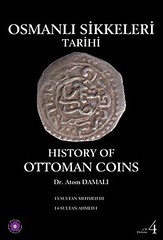 The 4th volume of the book "History of Ottoman Coins" studies in detail the coins of Sultan Mehmed III and Sultan Ahmed I.
The 4th volume of the book "History of Ottoman Coins" studies in detail the coins of Sultan Mehmed III and Sultan Ahmed I.
Under the influence of the military, economic and social structure, the Ottoman money system naturally moved towards a new process by the end of the 16th century. This process lasted approximately one hundred years during the 1600s and struck a heavy blow to the Ottoman financial structure. The Ottoman mines, which were unable to compete with the cheap silver ore that Europe obtained from America, began to shut down one after another. This was followed by the shutdown of mints. Thus, the coins of Mehmed III and Ahmed I, the early sultans of this period, were struck under these difficult conditions.
This volume of the book, expected to be completed in 9 volumes, gives useful information on Sultan Mehmed III and Sultan Ahmed I, conveying
- Chronological events of their 22 years reign
- Major historical milestones in their reign
- Coins of the Sultans explained in detail
The volume includes the pictures of 270 silver and gold coins of Sultan Mehmed III and 200 coins of Sultan Ahmed I. Furthermore, this section comprises also the regional history related to the 40 cities striking this epoch's Ottoman coins, describing the characteristics of the coins struck in those cities. The last section of the book depicts a coin inventory related to the Sultans.
Heading History of Ottoman Coins - Volume 4
Author Dr. Atom Damali
Language Turkish and English in the same book
Pages 360 pages all in color
Published By Nilüfer Damalý Education, Culture and Environment Foundation
Size 210 x 297 cm
Binding Hard cover
Price 160 USD (postage paid)
Payment Paypal or bank transfer
Order from
niluferdamalivakfi.org/eng/gallery.asp?ID=36&CID=&PID=471&do=showdetails
For another source, see:
www.zerobooksonline.com/eng/product_details.asp?
cat=&subcat=&product=6351
NEW BOOK: MILITARY TOKENS OF THE BRITISH COMMONWEALTH
Yarwood, John F. Military Tokens of the British Commonwealth
Latest and final edition with hundreds of listings, new numbers, good photos (some color!) and square-bind, plus detailed background information where known. Covering 17th Century to Iraq with focus on canteens, but club tokens, tool checks, even POGs as well. This is the standard work on the subject and the author says it is his last edition. Both previous editions have gone out of print shortly after release. Specs: 273 pages, 5.75x8.25", softcover, 2011
List $50. Our Price $45 Postage USA Media Mail $3; USA Priority $4.95; Foreign Airmail $13.95; Canada $11.95. Check, VISA/MC, Paypal OK
For Contents, Cover, and sample page, or to browse our other Exonumia book offerings: www.coincoin.com/bkZZ.htm#YARW
http://www.CoinCoin.com
Scott Semans
P.O. Box 2347
Issaquah, WA 98027 USA
425-369-1725
8AM-7PM best
THE BOOK BAZARRE
BOOK REVIEW: MONEYMAKERS BY BEN TARNOFF
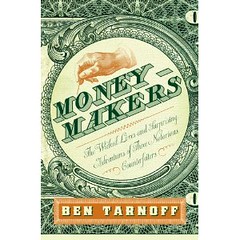 For some time I've been wanting to get around to writing up a review of what I found to be a great book. Moneymakers by Ben Tarnoff is a very interesting read and I'd consider it a must for any collector of U.S. colonial, Confederate or obsolete banknotes.
For some time I've been wanting to get around to writing up a review of what I found to be a great book. Moneymakers by Ben Tarnoff is a very interesting read and I'd consider it a must for any collector of U.S. colonial, Confederate or obsolete banknotes.
Honestly, I wasn't sure what I'd make of this book at first. My library shelves are already well stocked with books relating to counterfeiting, and my fear was that a writer from outside the hobby would simply rehash many of the same stories we've read before. Tarnoff is a 2007 graduate of Harvard University, but his book is a great debut for a new writer on numismatic topics. His viewpoint is that of an historian, and he does a wonderful job of placing the events and artifacts in historical context.
The book is nicely laid out in three sections, one each dealing with counterfeiting in the colonial, antebellum and Civil War eras. To provide a focus and narrative explaining the larger social, political and economic context of each era, Tarnoff builds each section around the tale of one standout individual. This is an effective device; it eliminates the clutter of history while still illuminating the situations, personalities and motivations that shaped the times.
The eras are represented by Irish immigrant Owen Sullivan (1720-1756), outlaw hero David Lewis (1788-1820) and shopkeeper Samuel Upham (1819-1885). Only Upham is generally known to numismatists today, for his replicas of Confederate currency. But all three were notorious in their day, making a large impact on the scene.
The book drove home to me just how damn hard life was in the early years of the republic. For that alone I enjoyed it immensely. It was the window it provides on history that most attracted me to numismatics in the first place, and that connection can become lost as hobbyists distill those details away in their quest for just the most relevant numismatic facts.
Tarnoff correctly notes how some tales relating to these notorious counterfeiters spread both by newspaper accounts and word of mouth, passing "from one person to the next, the details varying slightly with each storyteller, until someone years later committed to print whatever version had survived. "
Here's one story which helps show how Lewis came to be popularly known as a dashing "Robin Hood" character.
One day, Lewis came to the home of a destitute widow. She didn't have a single dollar to pay her rent, the woman confessed, so the constable would soon seize her cow, her last means of support. "I don't know what to do without her," she fretted. Lewis asked how much she owed, promptly handed over the exact amount and then hid nearby. When the official arrived, the widow offered up the money and, satisfied, he continued on his way until Lewis appeared in his path and put a gun in his face. The robber retrieved the bills he had lent the widow along with the rest of the cash the constable had on him, making a nice profit. (p142)
The book is filled with numerous such anecdotes, including a marvelous double-cross story of how the Confederate government tricked the U.S. government into shutting down a maker of counterfeit Confederate notes (one of Upham's competitors).
Tarnoff's book owes its existence to another recent book on the topic, Stephen Mihm's A Nation of Counterfeiters: Capitalists, Con Men, and the Making of the United States. In his Acknowledgements turnoff notes that "After reading it, I called Stephen, who graciously took the time to speak with me. Our conversation made me want to read everything I could find on the topic, and set in motion the research that eventually produced a book proposal."
He goes on to note, When I first began researching this book, I wasn't sure what to expect. I cast a wide net, writing to archives, historical societies, and librarians around the country, and eventually visiting many of them in person." This wide net is quite evident in the 80+ page Notes section, which passed my "back of the book" test with flying colors. The 256 notes provide detailed backup of the facts presented in the narrative, and make for fine reading on their own. I would encourage everyone to take the time to read this section, for it provides an excellent guide to information to be found in both numismatic and non-numismatic sources.
As just one example, "In 2001, a portfolio of Upham's facsimilies was discovered at an auction in Pottstown, Pennsylvania. The portfolio was prepared by Upham for his friend George William Childs, a journalist and publisher of the Philadelphia Public Ledger". This discovery was recounted by George Tremmel in a 2006 Paper Money article and again in his book, A Guide Book of Counterfeit Confederate Currency.
As a bibliophile and collector of numismatic ephemera I great appreciated the image of a "Half Price! Half Price!" advertising circular offering "Confederate Notes and Shinplasters". The May 30, 1862 broadside by Samuel Upham is from the collection of The Library Company in Philadelphia.
There are far too few illustrations in my opinion - I think the book could have been enhanced with the addition of more images of counterfeit and genuine notes, documents, and other artifacts. But those are available elsewhere (at least to numismatists like myself with a decent library). The true value of the book however, lies in the narrative and the copious research behind it. Thanks are due to Ben Tarnoff for writing this book, and here's hoping it's not his last on a numismatic topic.
Earlier this week I lamented to an E-Sylum contributor that there are far too many 2nd, 3rd and 4th editions of numismatic books coming out lately, and far too few completely new books. More writers should do original research, and thanks to this outsider, we do have an important new book for numismatists.
To read an earlier review by Arthur Shippee, see: BOOK REVIEW: MONEYMAKERS: ADVENTURES OF THREE NOTORIOUS COUNTERFEITERS (www.coinbooks.org/esylum_v14n06a09.html)
RED BOOK LAUNCHED FAMILY BUSINESS 50 YEARS AGO
 Cedar Falls Iowa coin dealing family credit a coin book -- the Red Book -- for launching them into a two-generation family business.
Cedar Falls Iowa coin dealing family credit a coin book -- the Red Book -- for launching them into a two-generation family business.
Bill and Irene Casey, and now son Tim Casey, have been been dealing in coins in the central eastern Iowa town for five decades.. This month they celebrate their 50th anniversary.
It all got started, they told Jim Offner, a writer for the local Courier that someone showed Bill Casey a "retail coin book." I checked by phone, chatting with son Tim that it was indeed the Red Book that got father Bill interested in coins that ultimately launched him into dealing in coins. Tim took over the shop when Bill retired.
"In the early years my father attended a lot of coin conventions and shows" said Tim. He mentioned he does not have time for this lately. "The reporter got some facts wrong, stating only ten to fifteen people a day come into the shop. That was how many came in when he was here. Over a hundred people a day come into the shop these days."
They deal in gold and silver and that has added considerable to the present shop activity.
Otherwise it was a nice article he stated. "My father is retired now. He will be interested to read your article in E-Sylum," he told me.
You can do the same reading:
To read the complete article, see:
Going for gold: Local coin shop marks 50th anniversary
(wcfcourier.com/business/local/going-for-gold-local-coin
-shop-marks-th-anniversary/article_737b1a4e-fb57-11e0-915d-001cc4c03286.html)
MORE ON AMERICAN FAROUK AUCTION ATTENDEES
Kathy Lawrence, Past President of the Dallas Coin Club writes:
Dallas Coin Club member and coin dealer Bob Schermerhorn was among those who traveled to Cairo for the ten-day coin auction. I saw him listed in the photo, but wanted to include the Dallas Coin Club connection
I have enjoyed the recent articles devoted to Americans who attended the Palace Sale of King Farouk's coins sequestered by the Republic of Egypt. One name that seems to elicit only the most limited recognition was a man shown in the group photo in the Oct. 16 issue: James P. Randall of Chicago. Here was a colorful character about I had learned a lot in the early 1950's.
At that time my family lived in Florida and my late brother John and I became what are now called YN members of the very active Miami Coin Club. The club had been founded in 1948 with Randall among the charter members. His name came up at nearly every meeting, especially if the business segment was a trifle slow.
It developed that member Randall (once a Chicago dealer with a major interest in Far Eastern material) had strenuous objections to the second slate of officers elected to lead the club. He expressed his distaste in a series of letters that were considered defamatory and the club expelled him forthwith. Randall then sued the club alleging that his expulsion was illegal. The matter passed through Dade County courts and on up to the Florida Supreme Court over the years at considerable expense.
Another club leader was the late William Fox Steinberg, a prominent dealer ordinarily noted for his calm and affable demeanor. "Foxy" came to a meeting in the 1950's and took the floor to read a section as written by the unhappy Randall, in which he offered a substantial cash reward ($10,000 if I recall correctly) "to any CHRISTIAN lady or gentleman who has heard me described as insane!" I noticed with surprise that "Foxy" was now quivering with fury, as he announced, "You know what I say to that !?! I say CHUCK YOU FARLEY!!!"
Soon after the state Supreme Court examined the suit, deciding that Randall had indeed been illegally expelled according to the bylaws! He was promptly re-instated and sent a new membership card. It returned virtually overnight, ripped into tiny pieces and stuffed into a sealed envelope! The membership cost ONE DOLLAR! What devotion to principle!
To read the earlier E-Sylum article, see: AMERICAN FAROUK AUCTION ATTENDEES (www.coinbooks.org/esylum_v14n44a06.html)
QUERY: PEWTER TRIBUTE MEDALS INFORMATION SOUGHT
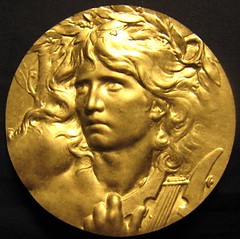
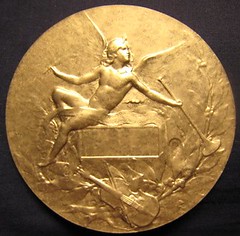
As a collector of French Art Nouveau medals, I have noted the recent appearance of "Pewter Tribute Medals" offered in the last few months by a single U.S. eBay seller. These pieces are inexpensive and appear to be modern reproductions of a variety of French medals, most notably of the Orpheus by Coudray.
Having purchased two of them, I observe that they are nicely done and quite accurate (Orpheus images attached). I have attempted to discover more about the origin and manufacture of these pieces by searching the internet and inquiring of the seller, but all websites lead right back to the eBay seller who is very polite but does not offer any details.
I'm curious to learn where and how these pieces are being made and seek input or information from E-Sylum readers.
MONTROVILLE WILSON DICKESON
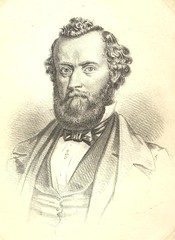 This week I have been doing research on Montroville Wilson Dickeson. E-Sylum readers should recognize his portrait from his American Numismatical Manual. I came across an unsigned review of his book from the Southern Literary Messanger for May of 1859.
This week I have been doing research on Montroville Wilson Dickeson. E-Sylum readers should recognize his portrait from his American Numismatical Manual. I came across an unsigned review of his book from the Southern Literary Messanger for May of 1859.
The first half of the review was a casual description from a writer who probably knew nothing about numismatics. The second half follows:
"We know nothing of Dr. Dickeson, the author of this elaborate treatise, but we should be inspired with a lively respect for his talent were it not for the portrait of himself, vilely executed, which deforms the frontispiece, and which as Macaulay said of Montgomery's likeness, he appears to be doing his best to look like a man of genius and sensibility, but with less success than his strenuous efforts would seem to deserve. The practice of inserting portraits of authors, in their earliest books, is one "more honored in the breach than in the observance.""
I have this to say to the reviewer, "It is a hundred and fifty years later. I remember Dickeson but I have no idea who you were."
THE NUMISMATIST NOW AVAILABLE FOR ANDROID PHONES
The Numismatist, the American Numismatic Association's monthly magazine, is now available in the Android Market. There is no charge for the app.
The magazine is a colorful, high-quality, educational publication for collectors of coins, tokens, medals, paper money and more. It was first published in 1888. ANA members receive the monthly print publication by mail, or they can read it online at www.money.org (login required).
The Android app allows users to access the same content as found in the magazine, but with the added convenience of being able to call it up anyplace they can connect to the Internet. The app includes back issues of the magazine as well as the most recent issue.
The Numismatist is also available in Apple's App Store for iPhone, iPod Touch and iPad devices. The log-in instructions for the Apple app are the same as for the Android app. Since its launch in April, 1,600 users have downloaded the iPhone app, and another 1,500 have downloaded the iPad app.
To read the complete press release, see:
www.money.org/AM/Template.cfm?Section=Home&Template=/CM/
ContentDisplay.cfm&ContentID=16469
KOLBE & FANNING NUMISMATIC BOOKSELLERS WEBSITE
THE 2012 LONDON OLYMPICS MEDALS
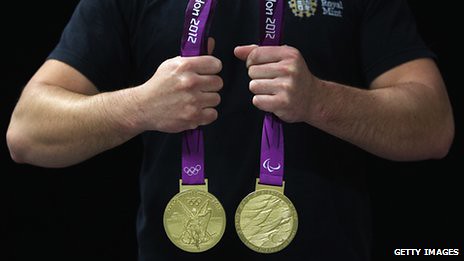
On an anonymous industrial estate on the edge of the south Wales Valley, Olympic dreams are being made.
For centuries the Royal Mint has made coins and military medals.
Now the first of the 4700 Olympic and Paralympic medals are slowly leaving the presses in Llantrisant near Cardiff.
Each medal takes 10 hours to make and will be stored in a secret strong-room deep inside the Mint before being taken to London for the games next year.
The process of creating a piece of sporting history is slow and painstaking.
After each five strikes they are rolled through a furnace heated to a blistering temperature of 750 degrees celcius (1,382 degrees Fahrenheit).
This softens the metal and allows the next stage of striking the design to take place.
Each medal is struck 15 times at 900 tonnes. It takes 10 hours to make each one.
When the medals are finished, they are taken to a special strong room.
It is such a secret and secure location that only a handful of staff members know its location.
The medals will remain there until it is time to take them to London, when they are officially handed over the the London Organising Committee of the 2012 games.
"On the front of the Olympic medal is Nike, the goddess of victory, with the ancient stadium that was rebuilt for the first modern Olympic games.
"On the other side is the London 2012 logo with the River Thames running through the back of it.
"The Paralympic one is different. On the outside of the medal we have braille.
"There's a depiction of the wings of Nike, so this is about transcendency and on the reverse we've got an area taken from the original sculpture of Nike which is just above her heart, so this side's about the heart of the Paralympic Games."
To read the complete article, see: London 2012: Olympic medals go into production in Wales (www.bbc.co.uk/news/uk-wales-15478810)
NOTES FROM E-SYLUM READERS: OCTOBER 30, 2011
Skewing Technique Goes Viral

How do you read a signature that is heavily slanted with the letters seemingly run together? Genealogists have that problem when trying to identify signatures but numismatists (coin and money collectors) also have the same problem when trying to identify signatures on banknotes and checks.
The answer?
Open a digital image of the signature in a photoediting program and then skew it (slant it) until the signature appears to be more vertical. A great example can be found in The E-Sylum, an electronic publication of the Numismatic Bibliomania Society, at http://www.coinbooks.org/esylum_v14n43a06.html.
Neat trick! My thanks to Shirley Wilcox for telling me about the article.
To read the complete article, see:
Skewing - A Technique for Signature Identification
(blog.eogn.com/eastmans_online_genealogy/2011/10/
skewing-a-technique-for-signature-identification-.html)
American Interactions with Paper Money
Anne E. Bentley of the Massachusetts Historical Society writes:
One of our Research Fellows has been working in our obsolete paper money collection and is presenting in what we call our Brown Bag series of conversations with the public. You bring your lunch and we provide the drinks and cookies while our researchers discuss their current projects. This promises to be an interesting foray into exactly how Americans actually used the pieces of paper we enjoy collecting todayâ¦
2 November 2011
Wednesday, 12:00 PM - 1:00 PM
Brown-Bag
Joshua Greenberg, M.H.S. and Bridgewater State University
Face to Face Value: American Interactions with Paper Money in the Early 19th Century
The proliferation of banks and other monetary minded institutions in the early republic fashioned more than the skeleton of a financial infrastructure, it saturated the nation with more than 5,000 unique legal and semi-legal forms of bank notes and shinplasters. This project examines how Americans engaged and actually used paper money as it circulated from person to person. Focusing on microlevel transactions, rather than macrolevel banking, it reveals the variety of ways people attempted to make sense of this chaotic system.
Free and open to the public
More Two-Faced Coins
Regarding the quiz question about U.S. coins depicting the same person on both obverse and reverse, Chris Fuccione writes:
There are a few you forgot in the trivia question. The 2009 Lincoln Cent has two examples: one of him sitting on a log and another one where is in front of the Springfield Illinois State Capitol.
Abe's in good company. Caroline Newton of Baldwin's in London forwarded a press release about the firm's upcoming sale of the Prospero Collection of ancient Greek coins. Featured is another "two-faced" coin.
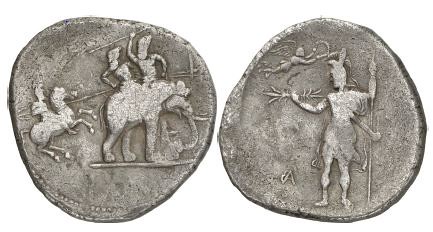
Lot 304 is without doubt one of the most historically important coins ever produced. The âPoros' dekadrachm of Alexander the Great depicts Alexander the Great on both the obverse and the reverse. An example was first published in 1887 (NC 1887, pp. 177-181). In 1973, a new hoard was found in Babylon (Coin Hoards I, 1975, 38), which increased the published examples from three to seven. It was this hoard that assisted with the dating of the issue to the lifetime of Alexander the Great. The above example, probably from the same hoard, surfaced in 1989.
For more information about the sale, see: www.baldwin.co.uk/prospero .
Who Says Paper Was Worth More Than Gold?
Tom DeLorey writes:
I challenge the article "When Paper Was Worth More Than Gold." Though the popular demand for one form of money (paper) may have been greater than the popular demand for the other form (gold), the two forms were fully fungible and of equal WORTH!
To read the earlier E-Sylum article, see: NOTES FROM E-SYLUM READERS: OCTOBER 23, 2011 (www.coinbooks.org/esylum_v14n44a14.html)
Medal of Honor Certificates
Fred Schwan writes:
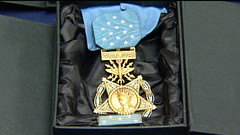 I liked the report about turning in the unissued Medal of Honor. I especially liked the report--first that I have seen--of a certificate being issued for the turn-in. I want one of those certificates! Well, I at least want to see one. It would be fun to have an unissued certificate!
I liked the report about turning in the unissued Medal of Honor. I especially liked the report--first that I have seen--of a certificate being issued for the turn-in. I want one of those certificates! Well, I at least want to see one. It would be fun to have an unissued certificate!
To read the earlier E-Sylum article, see: UNISSUED MEDALS OF HONOR TURNED IN TO AUTHORITIES (www.coinbooks.org/esylum_v14n44a15.html)
AUSTRALIA TOPS CANADA WITH WORLD'S LARGEST GOLD COIN
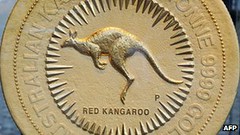 Australia has unveiled the world's largest gold coin, weighing in at a massive 1,000kg.
Australia has unveiled the world's largest gold coin, weighing in at a massive 1,000kg.
The Perth Mint produced it in time for Queen Elizabeth's visit to the city in Western Australia for the Commonwealth heads of government meeting.
The coin has a kangaroo on one side and the Queen's profile on the other. It is nearly 80cm in diameter and 12cm thick.
Perth Mint CEO Ed Harbuz said making it was "an incredible challenge, one which few other mints would even consider".
The Australian coin is five times heavier than the world's previous largest gold coin, made by the Royal Canadian Mint.
"We thought well, we'd better make it so much bigger that it'll stay the biggest coin in the world for a long time," Mr Harbuz said.
Australia's coin is 99.99% pure and has a nominal value of A$1,000,000 ($1,061,000; £663,000). The gold itself is worth more than A$50m.
To read the complete article, see: Australia unveils world's largest gold coin in Perth (www.bbc.co.uk/news/world-asia-pacific-15477426)
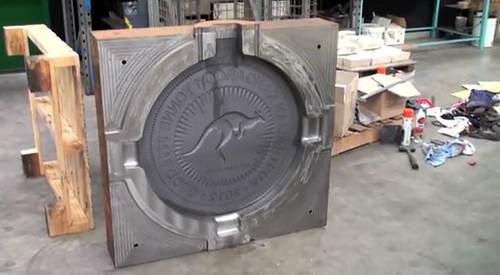
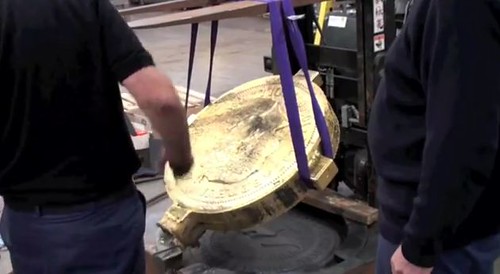
To view a YouTube video about the making of the coin, see: Perth Mint Makes World's Largest Gold Coin (www.youtube.com/watch?v=R1KoF8Ik24Y)
QATARI SHEIK ON COIN-BUYING SPREE
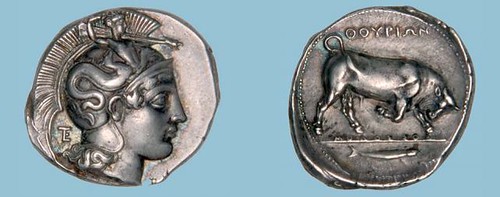
The beautiful stater from Thurion was estimated moderately at 6,000-8,000 pound sterling ($9,575-$12,767) before it went to auction at Morton & Eden's on October 24, 2011, as no 15. This piece is of quite an extraordinary provenance. It is from the legendary Kunstfreund collection and was sold for 30,000 Swiss Francs in 1974 at the peak of the coin boom. In 2011 some collectors might have been disposed to pay that prize again for this gem. They were outstripped. Sheik Saud bin Mohammed bin Ali al-Thani went up to 85,000 pound sterling ($135,659) to swallow the coin up in his collection.
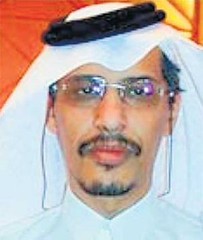 Nowadays it has become an usual scenario. The lion's share of the top auctions of ancient material - whether tetradrachms or fractions - goes to the bidder from Qatar. According to a preliminary addition of Hadrien Rambach, a London-based coin-advisor, who was attending the sale, the sheik bought 41 lots for over 1 million pounds (more than $1.5 million) during the recent auction of Morton & Eden.
Nowadays it has become an usual scenario. The lion's share of the top auctions of ancient material - whether tetradrachms or fractions - goes to the bidder from Qatar. According to a preliminary addition of Hadrien Rambach, a London-based coin-advisor, who was attending the sale, the sheik bought 41 lots for over 1 million pounds (more than $1.5 million) during the recent auction of Morton & Eden.
That included 70,000 pound sterling ($111,719) for a tetradrachm of the Aitna Master from Naxos, 40,000 ($63,839) for an archaic didrachm from Dikaia and 140,000 ($223,439) for an archaic double shekel from Tyre, the last two objects being also from the Kunstfreund Collection. Altogether we are talking about peanuts for the sheik. Only recently ARTnews chose him the biggest collector of 2011. His fine taste is lauded, while dealers will appraise his determination and financial exhaustlessness.
To read the complete article, see: The World's Biggest Art Collector Is Also Interested In Coins (www.coinsweekly.com/en/News/4?&id=845)
A HANDY GUIDE IN THESE VOLATILE TIMES
1938 "SUPERMAN" CHECK OFFERED FOR SALE
With the subject line "One of the most famous cheques ever...", Tom Fort writes:
As a cheque collector I am sure that you will think that this will be great for The E-Sylum.
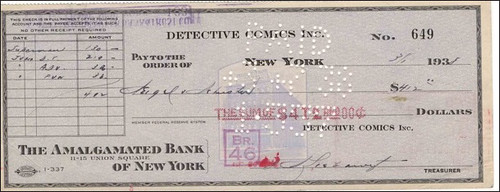
Characterized by Matt Fraction as "the most important $412 dollars in comics history," the check written to a young Jerry Siegel and Joe Shuster, in part, for the rights to Superman, has surfaced among the items for an upcoming auction.
"Have you ever made a business decision that haunted you?" writer Gerry Duggan tweeted Monday, pointing to images of the check. "This piece of true comics history will make you feel better."
Indeed that check, written March 1, 1938, by Detective Comics Publisher Jack Liebowitz, has been key to several legal and moral disputes, the first beginning barely a year after its signing. (Bleeding Cool notes an April 6, 1939, stamp on the back for the U.S. District Court of New York, suggesting it was entered as evidence in DC's copyright-infringement lawsuit against Bruns Publications over the Will Eisner-created Wonder Man.)
Of the $412, $130 was for the rights to Superman; the remaining $282 was in payment for stories contributed to Detective Comics, Adventure Comics and More Fun Comics. It's worth pointing out that Liebowitz managed to misspell the last names of both Siegel and Shuster, leading them to sign twice on the back.
The check will be among the items from Siegel's personal collection auctioned Nov. 14-30 by Comic Connect. Other memorabilia include Siegel's favorite suit and tie, clumps of his hair - yes, you read that correctly - his personal typewriter and a Superman script.
"Much has been made of the original 1938 $130 payment to Jerome Siegel and Joe Shuster," Comic Connect said in a statement. "Did DC Comics take advantage of two eager young men looking for their big break in the comic business or was this unequivocally fair business practice between comic book writers and publishers in a 1938 America? Whatever you believe, the $130 check is the quintessential symbol of this debate for the ages."
To read the complete article, see:
Check DC wrote in 1938 for rights to Superman goes up for auction
(robot6.comicbookresources.com/2011/10/check-dc-
wrote-in-1938-for-rights-to-superman-goes-up-for-auction/)
MORE BANKNOTES AS BUSINESS CARDS
David Fanning writes:
On "Banknotes as Business Cards," here is one of the coolest pieces of ephemera in my personal collection: a French Revolutionary assignat for 50 sols whose blank reverse has been printed as a business card for New York dealer Ed Frossard. With its skull and crossbones device and revolutionary legends, it is an unusually striking example of a banknote reformatted for use as a business card. It's the only one of these I've seen. I purchased it in a 2008 Smythe sale.
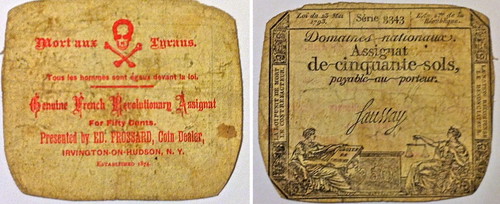
Pete Smith writes:
Attached is a scan of banknotes overprinted by Stanley Morycz. You might call these a business card but they are also "good for" trade tokens.
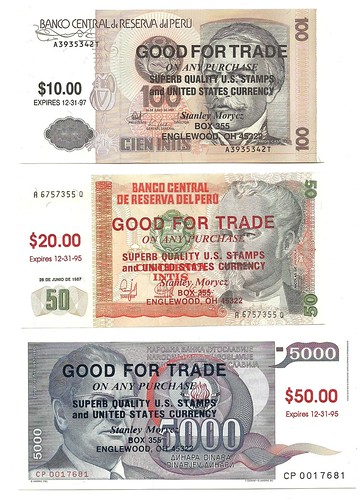
Peter Huntoon writes:
Here is a nice example from Bill Donlon.
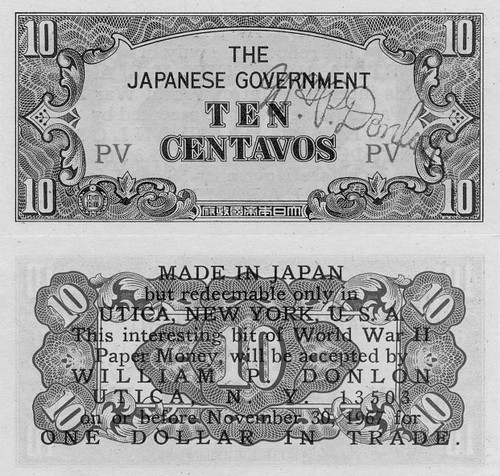
The name William P. Donlon in the 1960s and 1970s was synonymous with the sale of high grade, mostly large size type notes. His catalogs "United States Large Size Paper Money" and "United States Small Size Paper Money" coupled with his several auction catalogs are now part of our classic literature.
Donlon was an 'old timer' who was one of the few people actually present at all seven of the famous Albert A. Grinnell sales held from 1944 to 1946. He purchased and subsequently held many of the spectacular notes in that sale.
The depth of his holdings was revealed when he offered the major part of his remaining collection for auction in 1971. That sale was particularly rich in National Bank Notes and large size Federal type notes.
Mr. Donlon was a collector turned dealer. His primary occupation was that of owner of an amusement park in Utica. His dealing career began in 1958 upon his retirement from his business.
George Warner, a dealer from Sheridan Wyoming, who specializes in MPC, fractional currency and small size type notes, obtained the interesting advertising piece produced by Donlon shown here. It was included as part of an MPC collection that George purchased in 2004.
On the face is a red rubber stamped facsimile of Donlon's signature. On the back, overprinted in black ink in nine lines, is MADE IN JAPAN but redeemable only in UTICA, NEW YORK, U. S. A. This interesting bit of World War II Paper Money will be accepted by WILLIAM P. DONLON, UTICA, N. Y 13503 on or before November 30, 1967 for ONE DOLLAR IN TRADE.
Peter adds:
See the section below for the interesting story behind these advertising handbills. Another twist on an old idea.
With respect to the use of old currency as business cards and handbills, perhaps Ecclesiastes said it the best: "The thing that hath been, it is that which shall be; and that which is done is that which shall be done; and there is no new thing under the sun."
Or paraphrasing Harry Truman: The only thing you don't know about human endeavor is what you haven't read in a history book.

One of the most supremely beautiful series of bank notes ever created were the revolutionary issues for El Banco del Estado de Chihuahua. The bank never existed other than in concept, and the notes never circulated as legitimate money as far as I can determine. They were apparently designed as currency to be issued by Pancho Villa's government while he was the self-appointed governor of Chihuahua following his consolidation of power there during the revolution.
Many were used as movie money in 1940 vintage films - maybe even 1930 films - however I don't recall seeing many movies that employed El Banco notes. Far more commonly used were the El Estado de Chihuahua notes. Nevertheless, El Banco notes were apparently used widely, but the series had the disadvantage of having no 1000 peso. Some studio had crude 1000s printed for it which, if my memory serves me well, was accomplished by adding zeros to the 10 peso note. The faces of the spurious 1000s that I have seen are unattractive being offset printed in blue ink. You occasionally can find them for sale.
The other place the notes turned up was in border towns where American tourists were handed specimens by hawkers as they crossed the border. These contained advertisements overprinted on the backs. These handbills are particularly interesting, and highly collectable by specialists. At least they were used in commerce! They seem to have been utilized in several border towns, always, to my knowledge, with advertising for south of the border businesses. I believe they were used particularly heavily in Juarez and Tijuana. Naturally the survivors are somewhat dog eared because they were used.
I understand from dealers that only the low denominations were used as handbills. I have observed 5s and 10s but my exposure to them is very limited so my observations should be considered incomplete. A nice example is illustrated here. It exhibits a rather sloppy cut revealing that it was probably trimmed from the sheet using a hand operated paper shear after the advertisement was overprinted.
I have seen this phenomenon, but not being a "ragpicker" I have not paid much attention. Some notes are one-sided, and thus convenient for overprinting on the blank side. The Williams overprint blends in with the rest of the note's design.
Possibly more interesting are propaganda notes, which look like banknotes at a glance, inducing people to pick them up off the ground. Nazi notes attacking "the Jew Morgenthau" (Roosevelt's Treasury Secretary) come to mind. Many a New Yorker has stooped to pick up a $20 bill, only to be apprised by non-standard inscriptions that one should not store up his treasures on Earth.
Politicians have used paper money imitations as handbills. That erstwhile politico John Wilson issued a very attractive $3 bill for an ANA election. (He won.) Paper money is a perfect size for a handbill, but not a business card. In the late 1800s, paper trade cards -about the size of postcardsâ"were very popular, but their use subsided, possibly because so many were produced in Nuremburg (Germany), and then came World War One.
Advertising notes are not uncommon. My Favorite is the Hair-Oil notes -hundreds of them-- that Mae West, peeking quickly into W.C. Fields' suitcase, takes for real in "My Little Chickadee", inducing her to marry him for his "money".
I myself employ a variation on this theme. I print my business card on adhesive paper and stick It on New York City bus-&-subway "MetroCards". They are plastic, so you can't write on them, but out-of-towners think they are a cool NYC collectible. New Yorkers commend me on "going green". People have called me a genius, but I think, if only this one time, their standards are too low.
This is approximately the 163,765th consecutive business idea of mine which no one else has copied.
To read the earlier E-Sylum article, see: BANKNOTES AS BUSINESS CARDS (//www.coinbooks.org/esylum_v14n44a23.html)
QUERY: THE 1841 MAUNDY THREEPENCE
I am writing from Canberra, Australia, and as the subject heading for this email indicates, I am seeking information about Maundy threepences - in particular the 1841 Maundy threepence. The background to my inquiry is as follows:
In 1938 a cattleman in the far north of South Australia came across what he took to be seven skeletons of white men arranged in a circle about 30 metres across. New of his discovery got back to the South Australian Government and led to an expedition to examine the bones on the chance they could be the remains of the lost explorer, Ludwig Leichhardt. Leichhardt set out from the Darling Downs in 1848, intending to cross the continent from east to west (about 2500 miles in a straight line).
He had six companions, 50 bullocks, 20 mules, seven horses and all the equipment needed for an expedition of two to four years. He never turned up and no trace of him or his expedition was ever found. Numerous expeditions went in search, lots of relics found (none of which could be linked to Leichhardt), many Aboriginal stories heard of white men dying or being killed beyond the frontier, but nothing could be pinned down.
When the Government team got to the place where the cattleman had seen the 'skeletons' they had been trampled into fragments by cattle, and examination of these fragments revealed that they were mostly calcified tree roots rather than bones. However, there were a few fragmented teeth mixed in so the next morning the team set about sieving the sand to see what might turn up.
What they found were highly corroded pieces of iron, including an old packsaddle ring, some small pieces of extremely desiccated leather, some more tooth fragments, some fragments of human bone, and two coins - one an 1817 half sovereign and the other a very worn 1841 threepence. Reports at the time said the threepence was identified by someone as a Maundy threepence. The report and subsequent stories about this coin said either that less than 2000 were minted, or almost 3000 were minted.
In 1841 Leichhardt was living in London and this coincidence has led various writers to suggest that he might have brought the coin out to Australia as a keepsake and had it with him on his last expedition. Either he lost it at the place where it was found or it was somehow obtained from him by Aborigines who lost it there.
I am at present writing a book on the history of the search for Leichhardt and as this coin is part of that story I'm checking the facts. From the internet I have found out the origin and history of Maundy coins, but I began to wonder,
1) Were 'ordinary' threepenny coins produced in 1841?
2) If they were, what, if anything, differentiates an 1841 Maundy threepence from an 'ordinary' 1841 threepence?
I have checked at the national Library of Australia and the only book they have is one written by Robinson (1977) and this doen't have the information I am after.
I have also checked with a local coin dealer who seemed to think that there was no difference in design between the two, but the Maundy coins may have been made with more highly polished dies so that the struck coins had a finer finish. If a Maundy coin entered general circulation it would soon be indistinguishable from the 'ordinary' coins.
A book the dealer showed me (Coins of England & the United Kingdom - Spink, 2008) said that there were 'ordinary' threepences issued in 1841, 'for Colonial use only'. If all this is correct, then the threepence found at the 'skeleton' site, being quite worn, could not reliably be identified as a Maundy threepence and all the speculation about a possible connection with Leichhardt is completely misplaced.
I would like to find an expert who can tell me whether in 1841:
A) ordinary threepences definitely were produced?
B) If they were, was the design of the Maundy and the ordinary threepence identical?
C) How many 1841 Maundy threepences were struck?
Everyone is very busy these days so I hope I am not asking too much of you. If you can answer any of my questions, I would appreciate references to cite in my book. If you cannot, perhaps you could put me in contact with someone who can help me.
MORE ON COINS AND MEDALS AND METEORITES
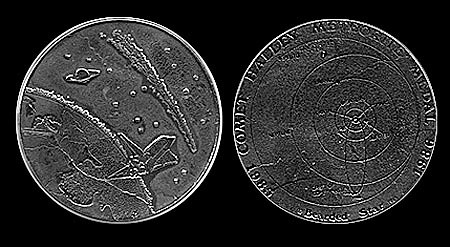
The Halley's Comet Meteorite Medallion. 2" diameter (silver dollar-sized) 1 full ounce (28 gm) of Odessa meteorite.
This was produced by a entrepreneur in Tucson, who bit off more than he could chew. The front side was designed by Kim Poor, the back shows the orbits of Halley and the planets. But when it came to actually minting the coins, they found the unearthly, crystalline metal took over 4000 degrees heat to melt, hotter than the surface of the Sun. Fortunately, a new induction furnace was being developed in Arizona which did the trick, but then Oxygen impurities made the medallions brittle. That problem was overcome, but by this time the comet had come and gone. Only a few hundred were made, and only a handful are left.
Hadrien Rambach writes:
On the subject of meteorites, because I prefer ancient coins myself, I have been interested in coins depicting meteorites. The well-known ones depict the stone of Emesa, about which I enjoyed the article by A.M. Antoniadi, "On ancient meteorites, and on the origin of the crescent and star emblem", Journal of the Royal Astronomical Society of Canada, vol. XXXIII.5, May-June 1939, pp. 177-184. It can be found online on http://adsabs.harvard.edu/full/1939JRASC..33..177A
Ray Williams writes:
Just thought I'd send pictures of a medal with a piece of a meteorite embedded in it. My wife Diane bought this for me from a coin dealer for Christmas 2008. Evidently, this meteorite was discovered by the Spanish in 1576 in Argentina. More info about this particular meteorite can be found at: http://www.meteoritemarket.com/CCinfo.htm
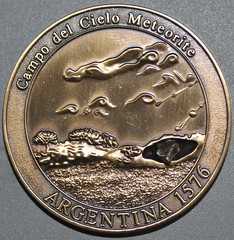
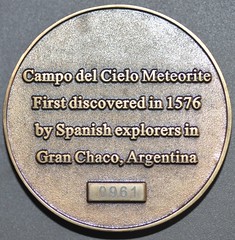
To read the earlier E-Sylum article, see: ON MOON ROCKS, METEORITES AND NUMISMATICS (www.coinbooks.org/esylum_v14n44a10.html)
THE BOOK BAZARRE
LIBYA'S TREASURE OF BENGHAZI COIN COLLECTION STOLEN
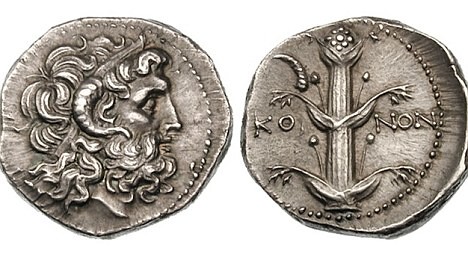
A gang of Libyan looters have raided a priceless collection of gold and silver coins that are believed to date back to the time of Alexander the Great.
The thieves carried off with the pieces, known as The Treasure of Benghazi, having drilled through a concrete ceiling at the National Commercial Bank of Benghazi. An expert has described the raid as 'one of the greatest thefts in archeological history.'
Whilst the break-in was initially believed to have been part of the uprising against Muammar Gadaffi, Hafed Walada, a Libyan archeologist working at King's College London told The Sunday Times; 'It may have been an inside job.
'It appears to have been carried out by people who knew what they were looking for.'
Alongside the coins, several artefacts, including monuments and figurines of bronze, glass and ivory, as well as jewellery, bracelets and medallions, are also believed to have been seized by the thieves.
Early leads had initially pointed to neighbouring Egypt, where a farmer had attempted to smuggle 503 gold coins and a golden statue through the port city of Alexandria, however attempts to locate him have thus far failed.
Most of the Benghazi treasures had been on Libyan soil following a mass recovery of the collection between 1917 and 1922 from the temple of Artemis, in Cyrene - an ancient Roman city, now Libyan territory and otherwise known as Shahat.
During the Second World War, much of the treasure was on display at the Museum of Italian Africa in Rome, but eventually returned to Libyan soil in 1961 and was kept at the bank.
To read the complete article, see:
Robbers make off with priceless Treasure of Benghazi after drilling into underground vault at Libyan bank
(www.dailymail.co.uk/news/article-2055283/
Libya-Robbers-loot-priceless-Treasure-Benghazi-bank-vault.html)
BITCOINS GO FROM VIRTUAL TO PHYSICAL
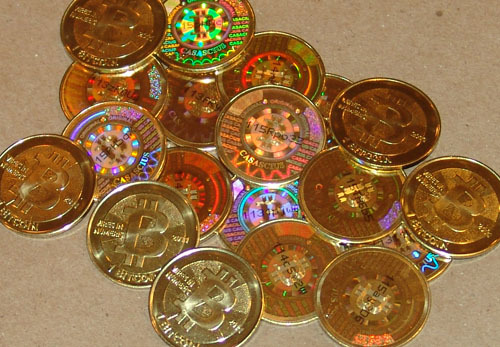
Bitcoins aren't just an abstract financial instrument living somewhere in the digital ether anymore. They're now a physical currency capable of taking a ride in your pocket or scratching off your lottery tickets.
The physical Bitcoins, called Casascius Bitcoins and created by a guy in Utah named Mike Caldwell, are made of brass, with gold electroplating on the 25 Bitcoin denomination. And, of course, they're tied to the peer-to-peer, open-source digital currency that's been exchanged on the Internet for a while now.
Each coin has a unique Bitcoin address and a redeemable "private key" under a hologram on the coin. That key can be used to redeem the value of the Bitcoins online, but the hologram sticker leaves a honeycomb mark when peeled back, so you'll know if your Bitcoins have been tampered with.
The coins play a function similar to a gift card or certificate with a magnetic strip or bar code. In other words, it provides a tangible means of carrying around the digital key that contains the actual value. There's just one problem--the physical Bitcoins may well be illegal.
U.S. statutes prohibit the creation of a currency that competes with the good ol' dollar. Before automatically crying foul, remember that PayPal uses dollars and other official currencies, and that things like various points and mileage programs and even gold and silver don't directly compete with the dollar, at least not yet.
To read the complete article, see:
Are physical Bitcoins legal?
(news.cnet.com/8301-17938_105-20125470-1/
are-physical-bitcoins-legal/?part=rss&subj=news
&tag=2547-1_3-0-20)
OBITUARY: SIR ARTHUR NORMAN, BANKNOTE PRINTER
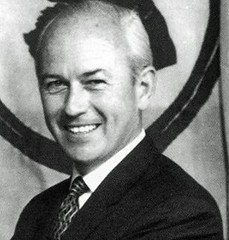 Sir Arthur Norman was no ordinary banknote printer. The former De La Rue chairman, who has died aged 94, once ran a clandestine operation in prewar Shanghai, printing currency for Chiang Kai-shek's Nationalist government in China under the noses of the Japanese occupiers. He pretended to manufacture playing cards and smuggled the notes out in dustcarts.
Sir Arthur Norman was no ordinary banknote printer. The former De La Rue chairman, who has died aged 94, once ran a clandestine operation in prewar Shanghai, printing currency for Chiang Kai-shek's Nationalist government in China under the noses of the Japanese occupiers. He pretended to manufacture playing cards and smuggled the notes out in dustcarts.
His derring-do was typical of the forthright approach of one of the leading industrialists of post-second world war Britain. After serving with distinction as a Royal Air Force pilot in the war, Norman went on to be president of the Confederation of British Industry and a leader of the growing environmental movement in the 1970s and 1980s, promoting the view that conservationists and industry should be partners rather than being at loggerheads.
In 1959 De La Rue created Security Express to transport valuables. Banknote factories were set up abroad, the company became security printer to the New York Stock Exchange and bought a US payment card company.
In 1960 it moved into bank automation and a year later acquired Waterlow and Sons, its great printing rival.
To read the complete article, see: City grandee who once smuggled for Chiang Kai-shek (www.ft.com/intl/cms/s/0/24ee2242-0091-11e1-ba33-00144feabdc0.html#axzz1c7lfQ4IG)
BANKNOTES WORTH MORE WHEN TORN IN TWO
A Czech bank clerk went on a banknote-ripping spree to take advantage of a change in the law that allowed her to easily earn a 25-percent bonus on her deposit, the police said on Thursday.
"The woman first withdrew 440,000 koruna (17,700 euros, $24,800) from her account. She asked for 88 used 5,000-koruna banknotes," Prague police spokeswoman Eva Kropacova told AFP.
Using helpers, the woman then tore the banknotes into two unequal parts and took the smaller pieces to banks all over Prague to swap them for real money.
"She knew that she would get 25 percent of the total value of the damaged banknote before a law change that took effect in July this year," Kropacova said.
She held on to the larger pieces of the ripped-up notes until the new law came into force.
Under the new rules, bringing the Czech Republic into line with the rest of the European Union, she got the total value of the banknote provided she handed in at least half of it, Kropacova explained.
The 46-year-old thus made a profit of 1,250 koruna on each banknote, or a total of 110,000 koruna, before she was arrested last week on charges of fraud.
To read the complete article, see:
Czech woman fools law, earns big by ripping up banknotes
(www.thenewage.co.za/33348-1020-53-Czech_woman_fools
_law,_earns_big_by_ripping_up_banknotes)
MARK WAGNER'S MONEY ART
Jeff Reichenberger writes:
I ran across this artist - Mark Wagner - in the Milwaukee Journal/Sentinel, who is making a lecture stop at the University of Wisconsin/Milwaukee. I checked out his website. Incredible stuff!
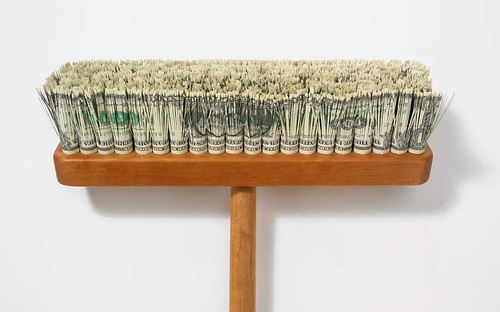
STATEMENT ON COLLAGE WITH CURRENCY
"The one dollar bill is the most ubiquitous piece of paper in America. Collage asks the question: what might be done to make it something else? It is a ripe material: intaglio printed on sturdy linen stock, covered in decorative filigree, and steeped in symbolism and concept. Blade and glue transform it-reproducing the effects of tapestries, paints, engravings, mosaics, and computers-striving for something bizarre, beautiful, or unbelievable... the foreign in the familiar."
For more information, see: www.smokeinmydreams.com
FEATURED WEB PAGE: LIBYAN BANKNOTES AND COINS
This week's Featured Web Page is on "Libyan Money Notes & Coins".
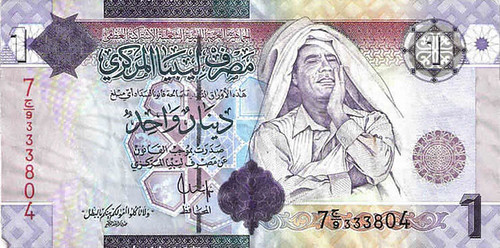
www.temehu.com/money-notes-and-coins.htm

